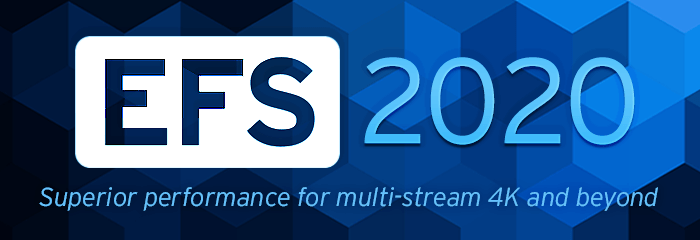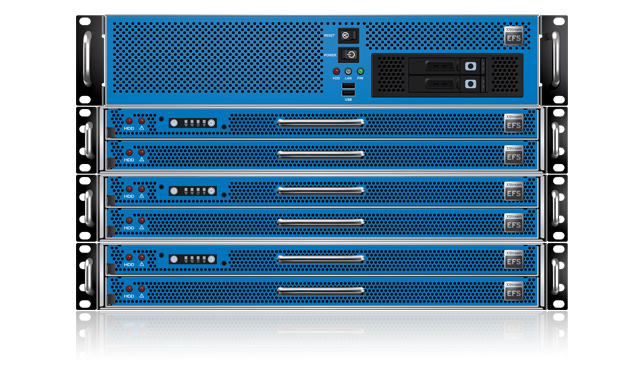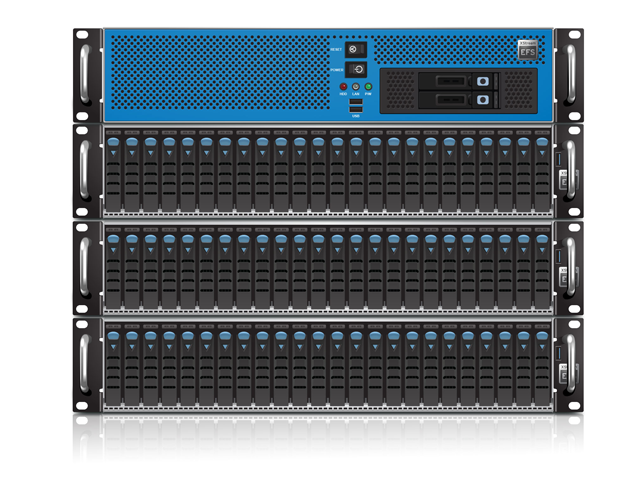ASUS ESC4000 DHD G4
ASUS ESC4000 DHD G4

ASUS ESC4000 DHD G4 Supports Up to 4 Double Deck GPU Cards in 1U.
All NVMe 8 SSD Featuring Maximum High Density and Minimum Low Latency in Upcoming 5G Network Ear.
Dual 10G On Board Plus 2 Networking Card for Upgrade.
1. Dual Processors, High Density, Maximum GPU in 1U
– Supports up to 4 double-deck active & passive GPUs in 1U
– Single Root for Maximum GPU utilizations on AI application
– High memory capacity for cache server usage
2. High Speed Transmission & Low Latency
– Onboard Dual 10G Base-T LAN ports
– Support Dual up to 100Gbps LAN cards (option)
– 4x 2.5” NVMe SSD & 4x M.2 22110 NVME SSD
– All NVME Low latency for Telecom on 5G application
3. Mechanism Innovation Design – Revolving Storage
– The first model with 4 front side HDD in 1U 4GPU
( Patent under applying process)
4. Scalable Expansion Capability
– 4* PCI-E Gen3 x16 slots for FH/FL add-on cards
– 2 * PCI-E Gen3 x16 slots for LP/HL add-on cards
5.Smart Thermal Radar design for energy efficiency
– HDD, CPU, GPU, PSU, Front panel
6. Target Market: Telecom, HPC, Deep Learning, Scientific & Research.
Additional information
Related Products:

MediaKind Video Storage and Processing Platform...


DIVA Version 8.0


8 Bay / 16 Bay EVO...


Gb Labs Unify Hub


SatRack


nxtedition


Strawberry


AirBox


Tiger Pool


Tiger Store


EditShare’s EFS 2020



EditShare EFS 450 Enterprise class Scale...


EditShare EFS 300


EditShare EFS 200


EVO DPX Shared Storage



ASUS ESC4000 DHD G4


Qumulo’s file data platform


OWC ThunderBay Flex 8


CODEX Media Vault


MoSMB


MoSMB-S3 Gateway


MediaGrid


MediaScaleX // Storage


Dell EMC PowerScale

MediaKind Video Storage and Processing Platform (VSPP)
For cable companies, multiple service operators (MSOs), telcos and content providers who need a cost efficient, reliable solution for massively scalable video storage and recording that exceeds stringent performance requirements, the MediaKind Video Storage and Processing Platform (VSPP) is the only field proven, large scale software-based solution that provides resiliency, very high throughput, and virtually hands-off maintenance. This platform is highly optimized to minimize hardware footprint and provide the best possible TCO.
Supported use cases
Cloud DVR
Cloud based DVR applications enable service providers to offer a DVR service without the need todeploy or upgrade to expensive DVR boxes at the subscriber site. By locating the storage and streaming at the network operation center and running an RS-DVR client software at the subscriber site, operators can offer a full DVR service without the need of hardware upgrades at the subscriber.
Dynamic origin server
The origin server is a scale out media storage system that can also perform content transformation, and streaming. The origin ingests MPEG-TS CBR and ABR, and transforms them on-the-fly to RTSP and different OTT formats, thus eliminating the need to store multiple formats.
VSPP tiered architecture
Supports different tiers to address specific streaming patterns as well as content popularity.
Edge pumps
With an ongoing transformation to the full-blown Media Edge for the legacy and OTT delivery.
DIVA Version 8.0
8 Bay / 16 Bay EVO Shared Storage Servers
- It’s incredibly fast, easily expandable, and its flexibility is unmatched.
- Workflow Project sharing, bin sharing, file sharing, SAN & NAS for professional media applications.
- Connectivity Enough ports to directly connect every computer in your workgroup.
- Performance High throughput, with overhead for the most demanding projects and 6K video workloads.
- Expansion Ready for more capacity and direct-connect network ports as your business continues to grow.
With EVO, you can connect and share everything — you’ll spend less and still get better performance. EVO is purpose-built for digital media workflows and demanding use with the leading pro apps like Avid Media Composer, Final Cut Pro/FCP X, Adobe Premiere Pro/CC, and DaVinci Resolve. When it comes to projectsharing, you can use Avid’s native Project and Bin sharing functions, and take advantage of EVO’s unique project sharing features for FCPX and Adobe Premiere Pro. EVO unlocks the sharing capabilities of Media Composer — with several editors in the same Avid project, teams can easily collaborate by using shared Bins, exchanging access to Media and Sequences directly within Media Composer. You also can Enjoy the flexibility and performance of both file and volume sharing. EVO enables you to use file sharing, volume sharing, or a combination of the two — providing multi-user write workspaces for sharing projects and bins, in addition to high performance SAN volumes for multi-cam and uncompressed workflows.
EVO is designed and built to make your production life easier, which means you get purpose built features like Slingshot and ShareBrowser. With Slingshot, an Automations GUI and API, you can create and run automated file workflows that span EVO, other storage systems, and Amazon S3/Glacier cloud services. Slingshot helps boost productivity by enabling you to automate repetitive file management tasks, leaving you and your team with more valuable time in post. ShareBrowser is an Easy-to-Use, unified file/project/asset management interface for macOS and Windows. It is similar to Finder/Explorer, but designed by SNS specifically to help media teams work and collaborate more efficiently. The ShareBrowser Desktop Client not only improves visibility and access to your team’s storage systems, it conveniently enables automatic project locking for FCP, Premiere Pro, and Pro Tools — as well as Avid project and bin sharing. enables your team to search across all EVO storage as well as local, offline, and other network disks. Assets and custom metadata like tags and comments can be instantly added to anything in the shared database. This means your team can more easily find, preview, and share important media and projects - and now, it's also available in a free web-app to make collaboration even easier.
Gb Labs Unify Hub
Seamlessly collaborate on media files and projects, no matter where in the world you're working.
Unify Hub is a unique GB Labs technology that extends our storage platforms to become a global unified file system.
This allows you to choose your workflow no matter where in the world your team members are working.
Local and distributed users have a fast, flexible, secure and seamless media storage experience.
SatRack
The 19" SatRack represents a leap forward in portable rack design. Providing superior levels of protection for the transportation and storage of 19"equipment as checked airline luggage. This innovative rack is available in standard sizes of 3U, 4U and 5U versions with a 480 or 610mm deep, lightweight welded aluminium frame. The frame is fully compatible with UK or US 19-inch rack-mountable equipment. The rugged textile outer cover is made from 1000 denier texturised nylon which is weatherproof and abrasion-resistant, doesn't rot and is used daily by military forces worldwide.
Specially designed for satellite uplinks and other applications where 19-inch electronic equipment needs to be transported and deployed without damage. This ultra-light 19" SatRack weighs just 8Kg for the 4U version and allows for the secure transportation of mobile electronics systems as checked baggage, whilst providing high levels of protection from shock and vibration.
Conforms to IATA guidelines for checked-in baggage.
nxtedition
Strawberry
AirBox
AirBox Multi Parallel Output allows simultaneous running of two or more SDI or IP streaming SD / HD outputs so that broadcasters can easily deliver parallel output in any combination needed to deliver the content.
AirBox supports a wide range of video / audio formats from almost every known platform for production Third-party video server files like Leitch, Seachange, etc. are supported natively.
Any modifications to the playlist can be made during the on-air session. There will be no locked videos in the playlist except the one being played at the moment. They can be changed, edited or substituted.
On-the-fly commands such as skip to next or jump can change the playback order. Such changes in order are carried out seamlessly without stopping the current session. The powerful Live Show Clipboard facilitates live productions, enabling the insertion and/or execution of different events or live streams.
AirBox enables playlist scheduling for weeks ahead for automated playout. The associated gaps and time overlaps are overcome dynamically to ensure smooth service even when timed activities interfere with each other. If content files or even entire schedules are missing and misplaced, special facilities guarantee continuous operation.
MS Windows 10 compatible.
Tiger Pool
Add smart storage pooling to your shared storage workflows with the Tiger Pool add-on for Tiger Store. This enables you to pool multiple NTFS volumes in a non-destructive way to perform live storage expansion, decommission aging hardware without incurring downtime, and optimize the use of free space available. To users and applications, the pool looks and behaves like a normal volume while each pool volume member preserves its original folder structure. If any pool member fails, you only need to worry about restoring a fraction of your dataset while the rest of your data remains available. You can freely add and remove pool volume members of different manufacturers, LUN size and performance characteristics without ever putting data at risk.
Tiger Store
Tiger Store is a cross-platform shared file system solution which enables you to build the most scalable NAS and/or SAN platforms. Tiger Store includes a metadata controller to enable high-performance collaborative workflows, as well as Windows, Mac and Linux SAN and/or LAN client connectivity, delivering the performance that teams of editors, artists, and colorists using Avid, Adobe, Autodesk, Blackmagic and other software need to ingest, edit, transcode and deliver content. Productivity and uptime are maintained with optional High Availability configurations. The Tiger Pool add-on for Tiger Store offers smart storage pooling for simplified data management. Tiger Store is available as a software-only solution or an integrated appliance.
EditShare’s EFS 2020
EFS 2020 powers faster EditShare storage nodes and networks on-premise, in the cloud and in hybrid configurations. The media-optimized file system features security improvements at every layer and enhanced throughput performance gains across the board. Fully compatible with Flow 2020, EFS 2020 enables media organizations to build extensive collaborative workflows, shielding creative personnel from the underlying technical complexity while equipping technical teams with a comprehensive set of media management tools. In addition to the powerful storage management tools built into EFS, the extensive set of RESTful APIs opens the door for customers and technology partners to automate advanced storage management workflows in a secure environment.
The latest EFS 2020 file system is built on all of EditShare’s storage nodes including:
EFS 200: For smaller boutique creative facilities
EFS 300: For medium sized facilities looking to grow to 1PB and beyond
EFS 450: For mission critical enterprise environments offering unlimited scalability
EFS SSD: For high data rate finishing environments
EFS 40NL: For parking of content and projects/Disaster recovery solution
EFSv: For clients looking to spin up an entire facility in the cloud
EditShare EFS SSD
EditShare EFS 450 Enterprise class Scale Out storage platform
EditShare XStream EFS 450 is a powerful distributed scale-out storage platform developed for the most intensive media workflows. It's designed from the ground up to support resilient large-scale workgroups requiring high-bandwidth, high-volume media ingest, transcoding, online collaborative editing and multiplatform distribution of HD, 2k, 4k and beyond.
Performance and resiliency
The XStream EFS 450 system is the original storage platform of the EditShare File System (EFS) family. EFS is uniquely tailored for intensive media environments with key benefits including one namespace that eliminates management of multiple storage volumes, Native Client drivers for improved bandwidth performance, plus ‘SwiftRead’ data contention management
EditShare EFS 300
EditShare EFS 200
EVO DPX Shared Storage
Qualified for 16-bit 4K DPX
- EVO DPX supports 16-bit 4K (4096 x 2160) DPX at 30fps right out of the box.
- A system with only 8 disks can handle real-world workloads of ~3,000 megabytes/s aggregate.
Powered by enterprise-class SSDs
- EVO DPX includes ultra high performance, high write endurance SSDs that help to deliver incredible throughput to colorists, VFX artists, and editors.
Supports Windows, Linux, and Mac
- EVO DPX enables your team to work and collaborate across multiple OSes. You can have a VFX artist on Linux, a DaVinci Resolve colorist on Windows, and Premiere Pro editors on Mac all working from the same storage system.
- Built-in 25Gb Ethernet connectivity
- Stream DPX/EXR and multiple streams of ProRes or other media over 25Gb Ethernet. In many cases you can even directly connect your workstations to EVO, no switch required.
Netflix deliverables? No problem.
- EVO DPX is qualified for up to 16-bit 4K DCI DPX and EXR @ 30fps. Perfect for handling demanding workflows like the ones required by Netflix.
- EVO DPX can be custom configured for even higher workloads, and options for 50Gb Ethernet connectivity are available.
- Effortlessly handle high-resolution 10, 12, and 16-bit image sequences.
Workflow harmony.
It’s now easier than ever to incorporate your DPX and OpenEXR workflows into a shared environment, alongside motion graphics and edit suites running Premiere Pro, Avid, or FCP X.
Focus on productivity.
By enabling real-time editing directly over the storage network, EVO eliminates the need for standalone RAIDs or individual drives for multiple workstations. This, in turn, eliminates the need to endlessly shuffle huge files. Editors, colorists, and other artists spend less time waiting and more time getting things done.
WARP
WARP is a linearly scalable, clustered storage and computing platform to support real-time workflows in the most demanding environments.
Its high-performance software-based file-management platform allows you to dramatically increase your workflow productivity by running applications directly on WARP where needed.
The WARP cluster creates a unified pool of efficient storage, with a proven 100% of storage utilization and a guaranteed and predictable performance. So you’ll need less physical storage for your data - reducing your capital and operating costs.
ASUS ESC4000 DHD G4
All NVMe 8 SSD Featuring Maximum High Density and Minimum Low Latency in Upcoming 5G Network Ear.
Dual 10G On Board Plus 2 Networking Card for Upgrade.
1. Dual Processors, High Density, Maximum GPU in 1U
- Supports up to 4 double-deck active & passive GPUs in 1U
- Single Root for Maximum GPU utilizations on AI application
- High memory capacity for cache server usage
2. High Speed Transmission & Low Latency
- Onboard Dual 10G Base-T LAN ports
- Support Dual up to 100Gbps LAN cards (option)
- 4x 2.5” NVMe SSD & 4x M.2 22110 NVME SSD
- All NVME Low latency for Telecom on 5G application
3. Mechanism Innovation Design – Revolving Storage
- The first model with 4 front side HDD in 1U 4GPU
( Patent under applying process)
4. Scalable Expansion Capability
- 4* PCI-E Gen3 x16 slots for FH/FL add-on cards
- 2 * PCI-E Gen3 x16 slots for LP/HL add-on cards
5.Smart Thermal Radar design for energy efficiency
- HDD, CPU, GPU, PSU, Front panel
6. Target Market: Telecom, HPC, Deep Learning, Scientific & Research.
Qumulo’s file data platform
Qumulo's cloud-native file system enables creative teams to easily shift active workloads to the cloud (AWS, Google Cloud), without application changes, to enhance collaboration across multiple locations, or burst rendering to the cloud, when needed.
See how our customers benefit with Qumulo:
https://qumulo.com/customers/cinesite/
https://qumulo.com/customers/msg-networks/
https://qumulo.com/customers/fusefx/
https://qumulo.com/customers/marz/
OWC ThunderBay Flex 8
The award-winning ThunderBay Flex 8 is a groundbreaking 3-in-1 solution that accelerates performance, capacity, and efficiency in digital imaging, VFX, video production, and video editing workflows. Bringing unrivaled potential and convenience, ThunderBay Flex 8 trailblazes through the biggest projects and deadlines. Its eight drive bays support a mix of SATA/SAS1 and U.2/M.22 NVMe drives for up to 128TB of storage capacity, and that’s only the beginning. You can saturate the Thunderbolt 3 speed threshold with real-world read/write speeds up to 2750MB/s. Connect A/V mixers, digital cameras, and desktop essentials, while charging mobile devices via Thunderbolt 3, USB-C and USB-A ports. Ingest hi-res video and photo files at speeds up to 985MB/s with front-side SD 4.0 and CFexpress card readers. Or add a video or audio card to the PCIe slot to ingest multi-stream large format footage or record high-quality tracks.
CODEX Media Vault
At the centre of your workflow, Media Vault delivers what you demand - performance that is sustained, shared, and scalable across different production departments.
With four 10GbE ports as standard, and options to add four more or even additional 25/50/100GbE ports, Media Vault can be configured to fit seamlessly into any network infrastructure.
Available as a stand alone NAS configuration with 12 drives providing a maximum 168TB or in a 2RU and 4RU rack mount design scaling up to 504TB with optional expansion capabilities. Learn more at https://mediavault.codex.online/
MoSMB
MoSMB is an enterprise-grade SMB (Server Message Protocol) NAS file server on Linux for running demanding workloads on modern storage systems. MoSMB supports high performance, high scalability and high availability in heterogeneous environments that include Windows, macOS and Linux computers. With a 64-bit architecture and no hard limits, MoSMB can store tens of billions of files and scale to multiple petabytes.
MoSMB feature list includes:
1) SMB v2 & SMB v3 protocol compliance2) Enterprise grade authentication via Active Directory and Kerberos.3) Support for NTLMv2-based authentication when authenticating local users.4) SMB v3 Encryption and Signing for ensuring safety and security of data.5) Supports VFS filesystems6) Supports S3 Object Store interface7) Choice of Windows ACLs and basic POSIX ACLs for authorization.8) User-ID mapping to map SMB identities to UNIX identities.9) Support for heterogeneous environment consisting of Windows, macOS and Linux clients.10) Single Global Name Space11) Durable & Persistent handles v1/v2 Transparent failover & continuous availability using Witness Protocol Scale-up architecture12) Active-Active Scale-out architecture13) Performance scaling by scaling up CPU and/or RAM.14) Supports RDMA or SMB Direct for high bandwidth and low latency use cases
MoSMB AdvantageMoSMB is a secure, feature-rich SMB file server. Its high performance and scalability can be leveraged for varied solutions including but not limited to:- High Speed File Server- NAS gateway for HPC/AI Storage- NAS gateway for Big Data Analytics- 2K/4K Media and Entertainment Workflows- Backup and Archival
MoSMB-S3 Gateway
MoSMB-S3 combines the features and ease-of-use of file systems with the scale and economics of object storage to deliver a powerful combination which caters to a range of data-intensive use cases such as Collaborative Media & Entertainment Workflows, Genomic Analytics for Life Sciences, Financial & Business Strategy Simulations, etc.
MoSMB S3 Cloud Gateway key features:
- Enforces native file system semantics including open mode flags and locks for read and write operations.
- Supports enterprise grade authentication via Kerberos in Active Directory environments.
- Inherits the powerful security features of the SMB 3 protocol for ensuring safety and security of data.
- Support for Windows, MacOS and Linux clients.
- Allows use of Mac Finder and Windows Explorer to browse buckets as standard SMB shares.
- Supports logical directory structure while maintaining compatibility with object store dash boards.
- Local data caching providing low latency & high throughput for the most active data.
- Caching of directory tree structure and metadata for faster response to metadata requests.
- Multi-threaded architecture allowing parallel uploads and downloads for faster read & write operations.
- High performance data transfer enabled by reads and writes over RDMA transport.
As enterprises increasingly opt to manage, store and process data in the cloud instead of doing it on-premises, being able to have a standards-based, secure, high performance POSIX file system interface to object storage is invaluable for HPC, AI/ML/DL, Big Data workloads in the cloud.
MoSMB S3 Cloud Gateway also has applicability in the Backup and Archiving applications and is particularly useful in Cloud Tiering, Cloud Active Archive, Cloud Burst and Cloud Migration scenarios.
MoSMB S3 Cloud Gateway supports top S3 compatible object storage providers out of the box. With hundreds of vendors in the cloud storage space customers can now pick and choose their cloud provider and can easily switch between vendors using MoSMB S3 Cloud Gateway thus saving operating costs.
MediaGrid
The MediaGrid system is purpose-built from the ground up to deliver high bandwidth and consistent low latency for video. Media operations can start with smaller MediaGrid systems — as little as 24 TB of usable capacity — and seamlessly scale to petabytes of capacity and tens of gigabytes per second of throughput. An industry-leading, high-density storage option — up to 504 TB of raw capacity in 5 RU — can reduce rack space by up to 60% and lower storage-related costs by up to 30%, minimizing total cost of ownership (TCO) through its exceptional price/performance capabilities.
MediaGrid features include:
High Scalability
The MediaGrid system is based on a fully distributed scale-out architecture, resulting in increased performance as additional storage nodes are added. As the system is expanded, bandwidth and capacity increase linearly, actually improving access speed to content already on the system.
Simple and Cost-Effective
Based on standard hardware components and cost-effective Ethernet technology, MediaGrid system is economical to purchase and maintain. There’s no need for file system reconfiguration as you scale, or for file system defragmentation as the file system ages.
Optimized for Media Workflow
The MediaGrid shared storage works with dozens of leading media systems, including Harmonic Spectrum media servers and ProMedia™ X Origin multiscreen media servers. It also enables collaborative editing workflows with nonlinear editors, such as Apple® Final Cut Pro®, Avid® Media Composer® and Adobe® Premiere® Pro.
Reliability and Availability
MediaGrid systems have no single point of failure, and leverage features such as dual active-active controllers with transparent failover, redundant data paths to protect against storage node failures, and transparent client failover to protect against controller failures. No down time is required even for activities such as software and firmware upgrades or adding storage nodes.
MediaScaleX // Storage
MediaScaleX // Storage is a software-defined, object storage platform that unifies online, nearline and archive storage into a single, shared, scalable cluster. It enables Media businesses to simplify and cost-reduce storage operations.
With a single UI into an exabyte-ready environment, and the ability to simultaneously store multiple pools of data in file (NFS, SMB) and object (S3, Rados, Swift) formats, MediaScaleX // Storage is one of a kind. Critical data protection functions like erasure-coding and data scrubbing are standard features to support data integrity and long-term retention. While in-built support for NVMe, SSD and HDD technologies enables clusters to respond to multiple performance requirements. Using the open Ceph storage engine at its core, MediaScaleX // Storage is hardened, robust, flexible and above-all built for scale.
Launched in 2015 to address Multi Service Operators' requirements for cloud DVR storage, MediaScaleX // Storage was designed from the ground up to combine high intensity ingest, record and playout processes with the need for deep archiving of VOD and customer-recorded content. This same solution supports any Media business to unify islands of storage into simpler, more scalable systems. And with high-performance integration with the MediaScaleX // Origin platform, content can be streamed on demand from any part of the storage cluster.
As Broadcasters and Post-Production operations target storage simplification, more workflow agility and cloud-compatibility, object storage is becoming more important. MediaScaleX // Storage provides cloud capabilities in an on-premise platform to allow Media businesses to easily scale and manage storage as requirements evolve.
Dell EMC PowerScale
Collaboration drives media workflows. Centralizing assets into streamlined shared storage helps media organizations drive collaboration, accelerate production and reduced costs by eliminating separate “silos” of video assets. Centralized storage can help unlock collaborative tools and processes that allow artists, systems and broadcast engineers to leverage common stored assets whether on premises or in hybrid cloud workflows. Dell EMC PowerScale builds on the legacy of Isilon to offer a consolidated, collaborative storage environment that enables concurrent, real-time collaboration with multi-protocol access, integration with key partner software and easy search across multiple storage methods.
R&S®SpycerNode
R&S SpycerNode represents the first in a new breed of storage systems that harness the latest advances in High Performance Computing (HPC), a term that refers to the system’s performance, scalability and redundancy. HPC is a combination of hardware, file system and RAID approach. HPC employs redundancy using software “RAID” technologies called erasure coding in combination with declustering to increase overall performance and reduce rebuild times. Also, system scalability is almost infinite and expansion is possible during operation.
The most compelling aspect of R&S SpycerNode is its building-block characteristics. It provides the ability to build a single global name space with different speeds of storage node.
In developing R&S SpycerNode, Rohde & Schwarz engineers have looked at many of the key issues that impact on media storage systems within high-performance video editing environments from annoying maintenance requirements – such as defraging – to much more serious system failures including dying disk drives, which can have catastrophic consequences to a project that is being worked on.
R&S SpycerNode features Rohde & Schwarz‘s device manager web application which makes it much easier to set up and use Rohde & Schwarz solutions in an integrated fashion. Device manager helps to reduce setup times and simplifies maintenance and service due to its intuitive web-based UI operated through a single client.
A critical requirement of any high-performance video storage system is proven data security. In developing R&S SpycerNode, Rohde & Schwarz has introduced data protection systems based on erasure coding and declustering. Erasure coding means that a data block is always written including parity.
Declustering is a part of the data protection approach of HPC setups (formerly known as RAID). It is software based and in comparison to a traditional RAID setup the spare disk is spread over all other disks and is not a dedicated disk. This will decrease rebuild times and reduce performance impact. Also, there are no limitations with the RAID controller, which results in much higher IOPS (Input/Output operations per second). Importantly, there is no impact on system performance over time due to declustering.
R&S SpycerNode comes in multiple 2U and 5U chassis designs, which are available with NL-SAS HDD and SAS SSDs in different capacities. An additional 2u24 chassis design is a pure flash system. There are main processor units and JBOD units. A main unit is always redundant, equipped with two appliance controllers (AP). Each AP features two 100 Gbit interfaces resulting in four 100 Gbit interfaces per main unit.
The combination of different chassis systems makes R&S SpycerNode applicable to a very broad range of applications. The 2u system represents a compact, lightweight unit that is ideal for application within mobile productions as well as offering a very dense, high speed storage device for on-premise applications. A larger 5u system offers sophisticated large-scale storage facilities on-premise within broadcast production centres and Post facilities.































